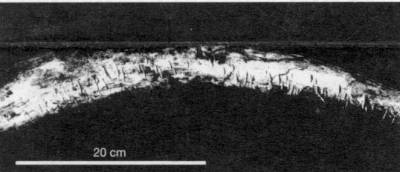 |
Science Frontiers ONLINE No. 138: NOV-DEC 2001 |
|
|
When The Arctic Was Warm
 These grooves on the Mamontovaya Kurya mammoth bones were made with sharp stone tools, but for what purpose? Was primitive notation in use 40,000 years ago? |
You will notice that we use the word "hominid" rather than human, because the campers may have been Neanderthals. No hominid bones were found to resolve this matter.
The implication of all of this is that, although the Arctic may have been very cold 36,000 years ago, it was largely ice-free.
(Pavlov, Pavel, et al; "Human Presence in the European Arctic Nearly 40,000 Years ago," Nature, 413:64,2001. Wilford, John Noble; "New Evidence of Early Humans Unearthed in Russia's North," New York Times, September 6, 2001. Cr. D. Phelps)
Comment. A nearly ice-free Arctic some 40,000 years ago might have permitted human diffusion into the New World, but so far we have seen nothing this early. It is likely that the Southern Hemisphere was also freer of ice during this period. Although humans had gained Australia by this time, we know of no good evidence that they used Antarctica and the islands of the Southern Ocean to reach the New World. But see a related item under GEOLOGY.
Other Sites of Interest
|